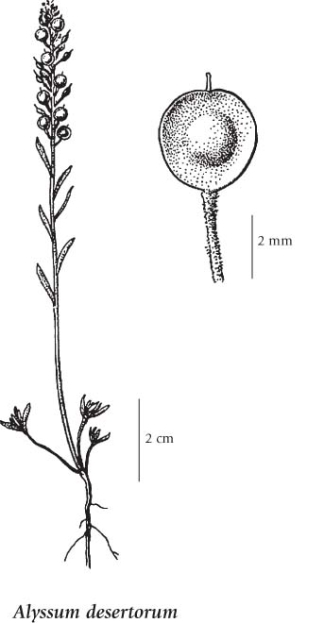Alyssum desertorum Stapf
desert alyssum (desert madwort)
Brassicaceae (Mustard family)
Introduction to Vascular Plants
desert alyssum (desert madwort)
Brassicaceae (Mustard family)
Introduction to Vascular Plants
Species Information
General:
Annual herb from a slender taproot; stems erect or ascending with several ascending branches near the base, 10-25 cm tall, the shoots grey-hairy with starlike hairs.
Leaves:
Basal leaves lacking; stem leaves narrowly oblanceolate, entire, 5-25 mm long, grey with starlike down.
Flowers:
Inflorescene elongate; flower stalks spreading, 2-5 mm long; flowers less than 3 mm in diameter; petals light yellow, very narrow, 2-3 mm long; sepals about 2 mm long, soft-hairy and with starlike hairs, deciduous shortly after fruiting.
Fruits:
Silicles, 3-4 mm long, round, shallowly notched, glabrous, strongly flattened near the edges and bulging over seeds, 2 seeds in each chamber; style about 1 mm long.
Illustration

If more than one illustration is available for a species (e.g., separate illustrations were provided for two subspecies) then links to the separate images will be provided below. Note that individual subspecies or varietal illustrations are not always available.
Illustration Source: The Illustrated Flora of British Columbia
Ecology
Ecological Framework for Alyssum desertorum
The table below shows the species-specific information calculated from
original data (BEC database) provided by the BC Ministry of Forests and Range.
(Updated August, 2013)
The table below shows the species-specific information calculated from
original data (BEC database) provided by the BC Ministry of Forests and Range.
(Updated August, 2013)
| Site Information |
Value / Class |
||
|
Avg |
Min |
Max |
|
| Elevation
(metres) |
1012 | 781 | 1130 |
| Slope
Gradient (%) |
54 | 1 | 140 |
|
Aspect (degrees) |
227 | 180 | 283 |
| Soil
Moisture Regime (SMR) [0 - very xeric; 4 - mesic; 8 - hydric] |
1 | 0 | 3 |
| Modal
Nutrient Regime
Class |
B | ||
| #
of field plots species was recorded in: |
6 | ||
| Modal
BEC Zone Class |
IDF | ||
|
All BEC Zones (# of stations/zone) species was recorded in |
IDF(5), PP(1) | ||
|
Source:
Klinkenberg 2013
|
|||